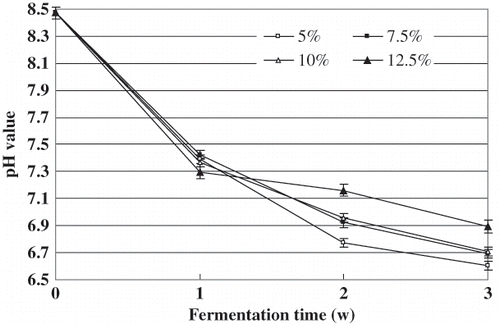Abstract
Douchi is a traditional salt-fermented soy product widely consumed in Southern China. The effects of sodium chloride (NaCl) supplementation on color, firmness, pH value, content of soluble protein and amino-type nitrogen of Douchi during processing were investigated. The results indicated that Douchi became dark and soft as the level of NaCl was increased. The contents of soluble protein and amino-type nitrogen increased during processing. The pH value increased in pre-fermentation, but decreased in post-fermentation stages. Lower salt content in Douchi resulted in lower firmness. Salt inhibited the hydrolysis of protein. SDS-PAGE results showed that the Douchi extracts were mainly consisted of low molecular weight peptides (less than 25kDa).
INTRODUCTION
Douchi is a traditional fermented soy product widely consumed in Southern China. Douchi is mainly used as a condiment for its unique flavor and taste. Similar products popular in the Southeast Asia are “natto” in Japan, and “tempe” in Indonesian. However, Douchi is different from them, because it is a salt–fermented soybean food. Sufu, Douchi (salt-fermented soybean), miso, and soy sauce are representative of the salt-fermented soybean foods. There are three types of Douchi classified based on the microorganisms used for fermentation, such as Dochi fermented by Mucor, Bacteria, and Aspergillus strains. Aspergillus-type Douchi is the earliest and most popular type, which is produced wildly in China.
As the population consuming foods with added Douchi is increasing, there is an increasing interest in its physical and functional properties. Our previous studies have presented the antioxidant,[Citation1,Citation2] anti-hypertensive,[Citation3] and α-glucosidase inhibitory[Citation4] activities of Douchi. Good quality Douchi products should have characteristic flavor, palatably soft texture, and a bright black color. Black soybeans are often used as the materials. Color and firmness are identified as important factors influencing consumer acceptability of natto.[Citation5] And firmness is also used as the parameters for judging the extent of ripening of Douchi during its processing.[Citation6] Chemical components are changed during Douchi fermentation by a series of complex biochemical reactions.[Citation7,Citation8] As in other salt-fermented soybean foods, such as sufu,[Citation9] miso,[Citation10,Citation11] salt has multiple roles in Douchi. After the salt had been added during post-fermentation, protein, lipid and starch were converted to peptides, amino acids, fatted acids, reducing sugars, ethanol, and various aroma components by salt-tolerant microorganisms.[Citation6] Salt also controled some enzyme activity in Douchi.[Citation8] However, less information on the effect of salt on the hydrolysis of protein and physical characteristics of Douchi is available.
In the present study, the changes of color, firmness, pH value, content of soluble protein, and amino-type nitrogen Douchi during processing were determined. The effects of sodium chloride (NaCl) on protein hydrolysis during Douchi preparation were also investigated.
MATERIALS AND METHODS
Materials
Black soybeans harvested in 2003 were provided by the Center of Soybean Research, Agricultural Academy of Jilin Province (Jilin, China). Aspergillus oryzae 3.951 was kindly donated by the Institute of Microbiology, Chinese Academy of Sciences (Beijing, China). All other chemicals were of reagent grade.
Douchi Preparation
Douchi preparation was performed as previous description.[Citation8] These steps and parameters are shown as follows: (1) Pre-treatment. Black soybeans were washed and soaked in tap water for 8 h at room temperature (24ºC ± 2ºC). After the water had been drained, the soybeans were steamed at 121ºC for 30 min in a retort (YMQ.L31.400, Beijing Jiangtai Medical Instrument CO., Ltd, Being, China). (2) Fermentation. The steamed soybeans were cooled to 30–35ºC, and then inoculated quickly with Aspergillus oryzae 3.951. The inoculated soybeans were incubated at 30ºC and around 80% relative humidity for 60 h in an incubator (LTI-601SD, Tokyo Rikakikai CO., Ltd, Tokyo, Japan). Semi-finished products were called Douchi qu (koji). (3) Post-fermentation. Aliquots of the Douchi qu deposited into a series of glass jars were salted until the content of NaCl reached about 5, 7.5, 10, and 12.5% (w/w). Each sample was ripened for three weeks at 35ºC in the same incubator.
Raw soybean, soaked soybean, and steamed soybean were also sampled. Samples were taken at 12 h intervals during fermentation, and at one-week intervals during post-fermentation stages. All the samples were lyophilized to a constant weight in vacuum freeze-dryer (FDU-540, Tokyo Rikakikai Co., Tokyo, Japan) and pulverized into powder using a mortar and a pestle.
Determination of Color
The color of soaked, steamed soybeans, Douchi qu, and Douchi samples were evaluated using the Hunter L, a, and b scale (with L representing the lightness on a scale of 0 (dark) to 100 (white), +a for redness, −a for greenness, +b for yellowness and −b for blueness) using a Chroma Meter CR-300 (Minolta Camera Co., Osaka, Japan). The fresh soaked, steamed soybean, Douchi qu, and Douchi samples (20 g) were mashed using a mortar and a pestle. Then the mashed samples were placed in a clear glass Petri dish (3 replicates), and color measurements were done in triplicate.
The colorimeter was calibrated before each series of measurements using a white ceramic plate (L* = 97.10, a* = +0.24 and b* = +1.80) and the Hunter L, a, and b values were recorded. Total color difference (ΔE) is a parameter, which quantifies the overall color difference of a given sample compared to a reference sample (soaked soybeans). Mean L, a, and b values were used to determine the ΔE between samples. The ΔE was calculated using the following equation:[Citation12]
The smaller the value of ΔE in different samples, the closer the samples are in color. Values of ΔE between 0 and 0.2 indicate an imperceptible color difference, 0.2–0.5 for a very small difference, 0.5–1.5 for a small difference, 1.5–3.0 for distinct, 3.0–6.0 for very distinct, 6.0–12.0 for great, and values >12 for a very great difference.[Citation13]
Determination of Firmness
The texture profile analysis (TPA) parameters were determined with a rheometer (RT-2002-D.D, RHEO TECH Co., Japan). All fresh samples were allowed to be equilibrated at the room temperature prior to the test. The firmness of Douchi samples was determined by the method described by Wei et al.[Citation5] with some modifications. A uniaxial penetration test was performed with a V-type probe. Crosshead and chart speeds were 60 mm/min and 100 mm/min, respectively. The maximum force was set at 2000 g. Firmness was expressed as the force (g) at the breaking point. Thirty replicate samples in each step were determined.
Determination of pH Value
The mashed samples of soaked, steamed soybean, Douchi qu, and Douchi samples (2 g) were added into 50 mL distilled water. The pH value was measured with a pH meter (pH/IonMeter F-23, Horiba Co. Ltd, Kyoto, Japan).
Determination of the Content of Soluble Protein and Amino-Type Nitrogen
For determination of the soluble protein content, the procedure followed the method of Chiou[Citation10] with some modification. One gram of freeze-dried powdery sample was added into a centrifuge tube and mixed with 10 mL of 0.3 M trichloroacetic acid (TCA) solution. The mixture was then homogenized using a T25BS4 homogenizer (IKA Labortechnik, Staufen, Germany). After 2 h homogenization, the tubes were centrifuged (8500 × g) for 20 min; 2 mL supernatant was withdrawn and deposited in a digestion tube with 15 mL of concentrated sulfuric acid and 5 g of catalyst (mixture of CuSO4 and K2SO4, w/w, 1/10). After wet combustion, the samples were distilled and titrated for the determination of nitrogen content by Kjeldahl method. The percent content of soluble protein in Douchi samples were calculated by dividing the TAC-soluble nitrogen by the total nitrogen in the substrate, then multiplying by 100.
The content of amino-type nitrogen was determined by the formol titration method by Judoamidjojo[Citation14] with some modification. Five grams of freeze-dried powder sample was added into a centrifuge tube and mixed with 50 mL distilled water, and then incubated in a water bath at 85ºC for 1 h. After it had been neutralized the supernatant (20 mL) with 0.05 N NaOH to pH 8.2, formaldehyde (10 mL) was added and the mixture was titrated with 0.05 N NaOH to pH 9.2. The percent content of amino-type nitrogen in Douchi samples were calculated by dividing the free amino-type nitrogen by the total nitrogen in the substrate, then multiplying by 100.
SDS-Polyacrylamide Gel Electrophoresis (SDS-PAGE)
SDS-PAGE was performed according to the method of Laemmli[Citation15] using 12.5% acrylamide separating gel and 4.5% acrylamide stacking gel. A 200-mg freeze-dried powder sample was mixed with 4 mL phosphate buffer (0.1 M, pH 6.8,). The mixture was then homogenized using a T25BS4 homogenizer (IKA Labortechnik, Staufen, Germany). The homogenate was incubated at room temperature for 1 h, followed by centrifugation (8500 × g at 20ºC) for 10 min. The supernatant was used in next step. After the electrophoresis, proteins were fixed and stained with Coomassie Brilliant Blue R-250. A low molecular weight (LMW) calibration kit (Amersham Pharmacia Biotech) was used as molecular weight standards.
Statistical Analysis
All sample analyses were statistical analysis done using SAS (version 6.12) developed by the SAS Institute Inc. (Cary, NC, USA). Duncan's multiple range tests were used to estimate significant differences among means at a probability level of 5%.
RESULTS AND DISCUSSION
Changes in Color during Douchi Processing
The changes in Hunter L-values, a-values, b-values, and total color difference (ΔE) during Douchi processing are presented in . During the entire processing procedure from soaked soybeans to Douchi, Hunter L-values decreased gradually, a-values increased, and b-values decreased but no gradual tendency. All ΔE values were greater than 12 suggesting a great difference in the color using soaked samples as control.
Table 1 Changes in Hunter L-values, a-values, and b-values and total color difference (ΔE) during in processing.Footnote a
The results suggested that the processing steps examined in this study, including soaking, cooking, and fermentation, could cause significant differences in Hunter L-values, a-values, b-values, and ΔE values (p < 0.05). Cooking and fermentation made the steamed soybeans darker, and decreased the L-values.[Citation5] Some new components were produced during the fermentation by complex biochemical reactions, similar to other soy products. Melanoidin, the final products of Maillard reaction process, was produced during soy sauce processing and was considered as one of the important contributors of the color of soy sauce.[Citation16] We suggest that melanoidin might have been produced during Douchi fermentation. It might be the main reason for the darker color of Douchi. No significant changes in Hunter L-values, a-values, and b-values were observed under various salt content schemes in Douchi (data not shown) (p > 0.05).
Changes in Firmness during Douchi Processing
The changes in firmness during Douchi processing are shown in . The firmness values of Douchi with 10% salt content were 138 g compared to 441 g in soaked soybeans. Therefore, there was a decrease in firmness from soaked soybean to Douchi by up to 31%. The moisture was also decreased significantly (p < 0.05) during processing. shows the changes in firmness of Douchi during Douchi post-fermentation at various NaCl contents. The firmness of Douchi decreased during post-fermentation. The firmness of Douchi with 10% salt concentration decreased rapidly from 225 g to 138 g within three weeks. The level of the firmness increased with the increase of NaCl content at the same fermentation time (p < 0.05) between 5% and 12.5% salt contents. The similar results were reported in sufu processing.[Citation9] The degradation of protein and lipid resulted in reduced hardness during sufu post-fermentation.[Citation9] Some components of Douchi, such as: protein, lipid and starch were converted to peptides, amino acids, fatted acids, reducing sugars, ethanol, and various aroma components by salt-tolerant microorganisms during post-fermentation.[Citation6] Salt also controled some enzyme activity in Douchi and sufu.[Citation8,Citation9] It may due to higher level of hydrolysis of protein at lower NaCl concentration (discussed in following section).
Table 2 Changes in firmness and chemical parameters in Douchi processing.Footnote a,b
Figure 1 Changes in the firmness of Douchi during Douchi post-fermentation at various NaCl content. Results are mean + S. D. of thirty determinations. Bars with different letters were significantly different (p< 0.05).
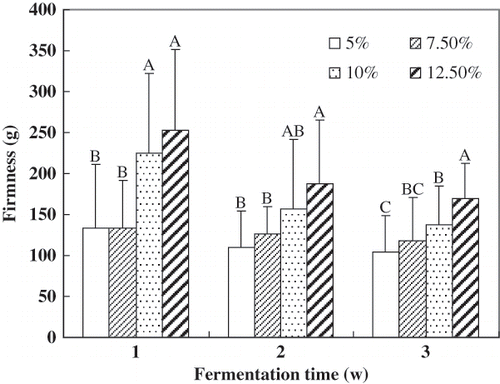
Fermentation decreased the firmness of Douchi and lower salt content in Douchi resulted in lower firmness. Wei et al.[Citation5] evaluated the firmness of natto. However, no published data refer to the textural properties of Douchi. In the absence of comparative standards, we propose that Douchi can be considered right for packing and distribution when the firmness has decreased to 100–150 g based on the limited subjective evaluations of Douchi manufacturing experts.
Changes in pH Value during Douchi Processing
The changes in pH during Douchi processing are shown in . The pH value increased rapidly from 6.88 to 8.43 during per-fermentation, followed by a rapid decrease during post-fermentation. shows the changes of pH value during Douchi fermentation. Marked increase in pH value was observed after 36 h.
Figure 2 Changes in pH value during Douchi fermentation. Results are mean ± S. D. of three determinations.
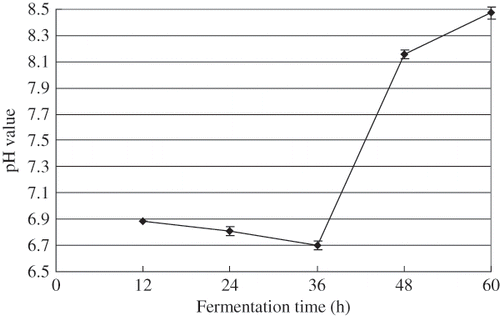
It has been proved that the fungi produces protease and hydrolyzed protein during Douchi fermentation.[Citation7] Most fermentation of soybean protein-rich materials with fungi caused a characteristic increase in pH value, such as in natto,[Citation5] tempeh,[Citation17] and thua-nao.[Citation18] It is postulated that the deamination of amino acid induced by Aspergillus oryzae 3.951 with resulting ammonia led to the increased pH. The formed ammonia also makes the substrate unsatisfactory for invasion by microorganisms, which might spoil the products.
shows the pH value during Douchi post-fermentation. The pH value decreased gradually during post-fermentation. The pH value decreased with the decrease of NaCl content at the same fermentation time. The pH values were 6.60 and 6.89 at 5% and 12.5% NaCl contents at third week, respectively. Salt–fermented soybean foods, such as Douchi,[Citation7] sufu,[Citation9] and miso,[Citation10] might go through post-fermentation process in the presence of salt, consequently reducing the pH value of the product. Chiou[Citation10] suggested that the decrease in pH value druing the miso post-fermentation was affected by Lactic acid bacteria (LAB) population. But, we suggest that amino acids and fatty acids production is responsible to decrease the pH value during the Douchi post-fermentation.
Changes in Contents of Soluble Protein and Amino-Type Nitrogen during Douchi Processing
The changes in the percent contents of soluble protein and amino-type nitrogen during Douchi processing are presented in . During the entire processing from raw soybeans to Douchi, the content of soluble protein and amino-type nitrogen increased significantly (p < 0.05). The soluble protein and amino-type nitrogen contents in Douchi during fermentation are presented in . The percent content of soluble protein and amino-type nitrogen both increased significantly from 11.07% to 18.98% and from 0.79% to 6.01% during the fermentation, respectively (p < 0.05).
Figure 4 Changes in the percent content of soluble protein and amino-type nitrogen during Douchi fermentation. Results are mean ± S. D. of three determinations.
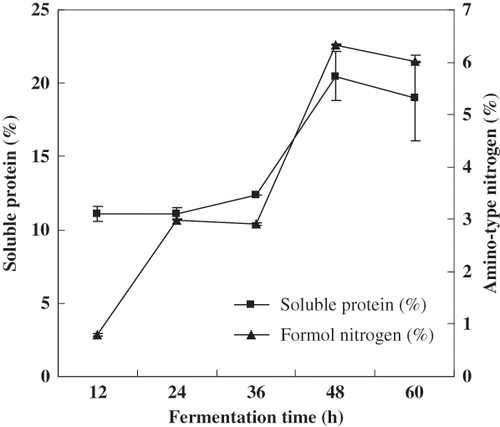
shows the percent content of soluble protein during Douchi post-fermentation. It suggests that the contents of soluble protein in Douchi increased significantly during the three weeks of post-fermentation (p < 0.05). The level of NaCl affected the percent content of soluble protein, which decreased with the increases of NaCl content, except the soluble protein content at 7.5% NaCl at the third week was 46.81%, which was a little lower than that at 10% NaCl content (48.51%). Soluble protein contents were found to be 53.81% at 5% NaCl and 42.26% at 12.5% NaCl at the third week. After post-fermentation, the soluble protein content exceeded 42% in all samples.
Figure 5 Changes in the percent content of soluble protein during Douchi post-fermentation. Results are mean ± S. D. of three determinations.
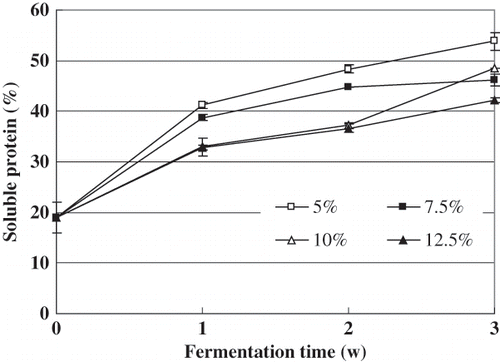
shows the percent content of amino-type nitrogen during Douchi post-fermentation. It suggests that the content of amino-type nitrogen in Douchi increased significantly during the three weeks of post-fermentation (p < 0.05). The rate of increase of amino-type nitrogen content in the products during fermentation increased significantly with the decrease of NaCl content. The level of NaCl affected the percent content of amino-type nitrogen, which decreased with the increases of NaCl content. Amino-type nitrogen percent contents were found to be 36.54% at 5% NaCl and 22.33% at 12.5% NaCl.
Figure 6 Changes in the percent content of amino-type nitrogen during Douchi post-fermentation. Results are mean ± S. D. of three determinations.
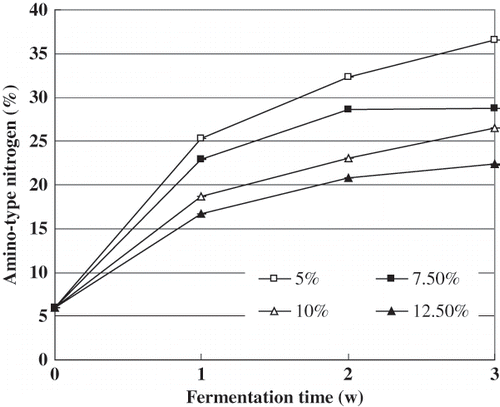
The percent content of soluble protein and amino-type nitrogen in Douchi products were much higher than that in the corresponding Douchi qu, which suggests that protein hydrolysis occurred mainly during the post-fermentation. However, added salt can inhibit the protein hydrolysis.[Citation9–10] Therefore, lower salt content in Douchi resulted in higher extent of degradation of protein and reduced hardness.
Changes in SDS-PAGE Pattern during Douchi Fermentation
SDS-PAGE can easily separate major proteins, and it has been applied to monitor the hydrolysis of miso[Citation19] and sufu.[Citation9] The SDS-PAGE pattern of the Douchi samples is shown in . Most of the bands derived from soybean proteins disappeared quickly during fermentation (lane 3). The bands derived from 7S globulin were disappeared after a 1w post-fermentation (line 4–7). The bands derived from 11S globulin were observed throughout fermentation, however, it became unclear gradually. The results show that high molecular weight proteins were gradually digested enzymatically with the formation of lower molecular weight derivatives. There was no significant difference among the samples bands with different salt contents at third week (p>0.05). The main components that formed the body of Douchi extracts were consisted of some low molecular weight peptides (less than 25kDa).
Figure 7 SDS-PAGE patterns of Douchi samples during processing. Lane 1: molecular weight marker; lane 2: raw soybean; lane 3: at 60 h in fermentation; lane 4–7: at 1 w in post-fermentation combined with 5, 7.5, 10, and 12.5% NaCl, respectively; lane 8-11: at 3 w in post-fermentation combined with 5, 7.5, 10, and 12.5% NaCl, respectively.

Aspergillus oryzae could produce an abundance of various endo- and exo-proteases.[Citation20] The content of soluble protein and amino-type nitrogen increased and low molecular weight peptides were produced during Douchi fermentation. It suggests that soybean protein were proteolyzed into low molecular weight water-soluble polypeptides or proteins during hydrolysis and further hydrolyzed into peptides and free amino acids by the proteases during fermentation. Sparringa et al.[Citation21] reported that approximately 65% soybean protein remained in the tempe as amino acids and peptides. In the case of Douchi, about 50% of the protein has been solubilized.
CONCLUSIONS
Our findings suggested that the low NaCl content Douchi was richer in the content of soluble protein and amino-type nitrogen than Douchi with a high NaCl content. Lower salt content in Douchi resulted in reduced hardness. The degradation of protein in Douchi leads to the liberation of free amino acids which are considered to be important flavour enhancing compounds in many fermented soybean foods. As such, Douchi with low NaCl content may be preferable from the viewpoint of public health concerns and a good flavor.
ACKNOWLEDGMENTS
This study was conducted within the framework of the collaborative research project between Japan and China titled “Development of sustainable production and utilization of major food resources in China” supported by Japan International Research Center for Agricultural Sciences (JIRCAS). This work was also supported by National Functional Food Project in the Eleventh Five-year Plan of the People's Republic of China (No.2006BAD27B09).
REFERENCES
- Wang , L.J. , Li , D. , Zou , L. , Chen , X.D. , Cheng , Y.Q. , Yamaki , K. and Li , L.T. 2007 . Antioxidative activity of Douchi (a Chinese traditional salt-fermented soybean food) extracts during its processing . International Journal of Food Properties , 10 : 385 – 396 .
- Wang , D. , Wang , L.J. , Zhu , F.X. , Zhu , J.Y. , Chen , X.D. , Zou , L. , Saito , M. and Li , L.T. 2008 . In-vitro and in-vivo studies on the antioxidant activities of the aqueous extracts of Douchi (a traditional Chinese salt-fermented soybean food) . Food Chemistry , 107 : 1421 – 1428 .
- Zhang , J.H. , Tatsumi , E. , Ding , C.H. and Li , L.T. 2006 . Angiotensin I-converting enzyme inhibitory peptides in Douchi, a Chinese traditional fermented soybean product . Food Chemistry , 98 : 551 – 557 .
- Chen , J. , Cheng , Y.Q. , Yamaki , K. and Li , L.T. 2007 . Anti-a-glucosidase activity of Chinese traditionally fermented soybean (Douchi) . Food Chemistry , 103 : 1091 – 1096 .
- Wei , Q. , Wolf-Hall , C. and Chang , K.C. 2001 . Natto characteristics as affected by steaming time, Bacillus strain, and fermentation time . Journal of Food Science , 66 : 167 – 173 .
- Zhang , S.H. and Liu , Y. 2000 . Prepare Technology of Seasoning , 85 – 95 . Guangzhou , , South China : University of Technology Press .
- Zhang , J.H. , Tatsumi , E. , Fan , J.F. and Li , L.T. 2007 . Chemical components of Aspergillus-type Douchi, a Chinese traditional fermented soybean product, change during the fermentation process . International Journal of Food Science and Technology , 42 : 263 – 268 .
- Wang , L.J. , Yin , L.J. , Li , D. , Zou , L. , Saito , M. , Tatsum , E. and Li , L.T. 2007 . Influences of processing and NaCl supplementation on isoflavone contents and composition during Douchi manufacturing . Food Chemistry , 101 : 1247 – 1253 .
- Han , B.Z. , Wang , J.H. , Rombouts , F.M. and Nout , M.J.R. 2003 . Efffect of NaCl on textural changes and protein and lipid degradation during the ripening stage of sufu, a Chinese fermented soybean food . Journal of the Science of Food and Agriculture , 83 : 899 – 904 .
- Chiou , R.Y.Y. 1999 . Salt-free miso fermentation using ethanol, sugars, and polyols . Journal of Food Science , 64 : 918 – 920 .
- Chiou , R.Y.Y. 2001 . Proteolysis during the fermentation of ethanol-supplemented miso . Journal of Food Science , 66 : 1080 – 1083 .
- Hutchings , J. B. 1999 . Food color and appearance , 2nd , 185 – 195 . Gaithersburg , MD : Aspen Publishers Inc .
- Young , K.W. and Whittle , K. 1985 . Colour measurement of fish minces using Hunter L, a, and b values . Journal of the Science of Food and Agriculture , 36 : 383 – 392 .
- Judoamidjojo , M. 1986 . The Studies on Kecap-Indigenous Seasoning of Indonesia , 65 – 68 . Tokyo : Memoirs of the Tokyo University of Agriculture .
- Laemmli , U.K. 1970 . Cleavage of structural proteins during the assembly of the head of bacteriophage T4 . Nature , 227 : 680 – 685 .
- Moon , G. , Lee , M. , Lee , Y. and Trakoontivakorn , G. 2002 . Main component of soy sauce representing antioxidative activity . International Congress Series , 1245 : 509 – 510 .
- Reu , J.C. , Wolde , M.T. , Groot , J. , Nout , M.J.R. , Rombouts , F.M. and Gruppen , H. 1995 . Protein hydrolysis during soyean tempe fermentation with Rhizopus oligosporus . Journal of Agricultural and Food Chemistry , 43 : 2235 – 2239 .
- Visessanguan , W. , Benjakul , S. , Potachareon , W. , Panya , A. and Riebroy , S. 2005 . Accelerated proteolysis of soy proteins during fermentation of thua-nao inoculated with bacillus subtilis . Journal of Food Biochemistry , 29 : 349 – 366 .
- Nikkuni , S. , Okada , N. and Itoh , H. 1988 . Effect of soybean cooking temperature on the texture and protein digestibility of miso . Journal of Food Science , 53 : 445 – 449 .
- Chio , M.R. , Sato , N. , Yamagishi , T. and Yamauchi , F. 1991 . Partial characterization of Aspergillus oryzae cell wall fraction-bound enzyme related to immobilized biocatalyst . Journal of Fermentation and Bioengineering , 72 : 214 – 216 .
- Sparringa , R.A. and Owens , J.D. 1999 . Protein utilization during soybean tempe fermentation . Journal of Agricultural Food and Chemical , 47 : 4375 – 4378 .
